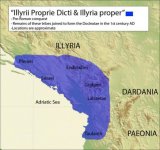Illyria
Iliria e Madhe
- Messages
- 115
- Reaction score
- 38
- Points
- 28
- Location
- Illyria
- Ethnic group
- Aryan Albanian Catholic Malësor
- Y-DNA haplogroup
- J2b2-L283>>>J-Z638
Correction: There are no ancient J-L283 in Albania and Montenegro because these regions haven't been sampled yet.Thats correct ....there are zero ancient J-L283 in Albania and Montenegro because the illyrians came from the north originally.....modern slovenia, croatia , eastern Austria ( we even have the Port of Vienna as Illyrian via Archeological studies ...not talking about the city of Vienna established by celts 500 years after ).................the ones in Foggia Italy are the Daunians who arrived there from modern southern slovenia in 1000BC
E-V13 is clearly a dardanian marker ( modern Kosovo ) and only went into coastal albania after Thracian invasion of their lands.............my guess is ancient Paeonian are also E-V13 and are related to the Dardanians
In the past you've talked about Illyria proper being the only true Illyrians, because the ones in the north were Celticized, now you're saying, "Illyrians come from the north originally so that's why there's no ancient J-L283 in Albania and Montenegro"
Surely if Illyria Proper are the true Illyrians, who came from the north, who were overwhelmingly J-L283, then we can expect the future samples to contain J-L283 in Albania and Montenegro (Which were part of Illyria proper in ancient times)



